-
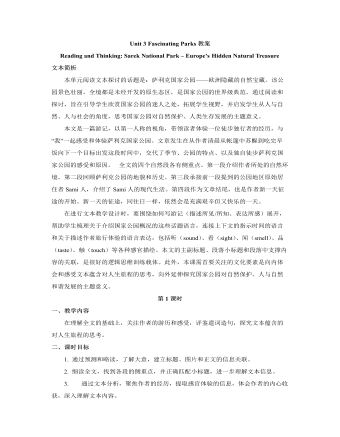
新人教版高中英语选修1Unit 3 Fascinating Parks教案
2. Explore the significance of the establishment of Sarek National Park.Q1: Which event is the most important one in the park’s history?Ss: The establishment of Sarek national park in 1909 is the most important one.Q2: Is it worth making a place like Sarek a national park? Give your reasons.Ss: Yes. In this way, the place can be kept in its natural state and natural beauties and other rare and valuable resources can be preserved instead of being destroyed by endless exploitation driven by profits.Q3: How does the writer organize his introduction to the history of Sarek?Ss: The writer organizes his introduction in the sequence of time, using time indicators such as “used to”, “around 9,000 years ago”, “soon after”, “following the reindeer”, and “in 1909”.Q4: What is the feature of the language used to introduce the history of the park?Ss: The introduction to the park is to provide facts, using time indicators to organize the events. Sentences starts with “third person” and passive voice is used more often, feeling objective.【设计意图】学生寻找和梳理公园历史上的重要事件,体会人与自然的和谐关系,评鉴介绍性语言的特点。【核心素养提升点】发展自主提取、梳理文本信息能力,训练逻辑思维和高阶思维。Activity 3: Highlighting the secret of the text
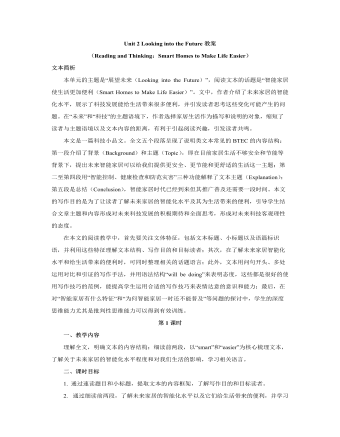
新人教版高中英语选修1Unit 2 Looking into the Future教案
【设计意图】以“新科技是一把双刃剑”为主题开展讨论活动。这个话题比较大,所以给了一定的限制,首先需要以智能家居为例来阐述科技发展对未来生活产生的影响,然后列举其优点和缺点,最后就以上现象发表自己的观点。这个活动是对整个文本的创意性总结与意义的升华,留给学生一定的想象空间,学生借此机会可以运用文本内容和语言表达自己对科技发展的看法和态度。Assignments:1. Finish Exercise 4 on Page 15 of the textbook.A smart home is one that integrated computers into the structure of the building itself. In this way, many of the things that we now do ourselves become automatic. For example, the smart home could control the air conditioning and lights so that you would no longer have to turn switches on and off, and so that your home would be more energy-efficient. The smart home could also monitor itself to make sure that everything is working as it should, and send you warnings if there is a problem. Such smart homes could even be programmed to detect your health problems, and then give you reasonable advice as to the food you should eat or if you should see a doctor. So, in a sense, smart homes will lead us to living smarter lives.2.Create a smart function for your home, and share your creation in the next period.
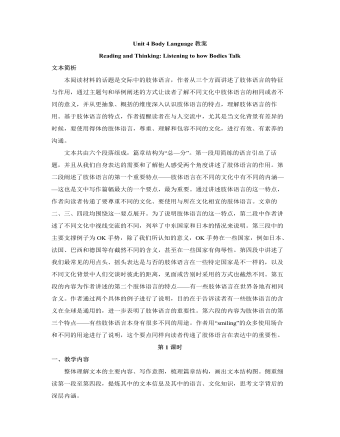
新人教版高中英语选修1Unit 4 Body Language教案
本阅读材料的话题是交际中的肢体语言,作者从三个方面讲述了肢体语言的特征与作用,通过主题句和举例阐述的方式让读者了解不同文化中肢体语言的相同或者不同的意义,并从更抽象、概括的维度深入认识肢体语言的特点,理解肢体语言的作用。基于肢体语言的特点,作者提醒读者在与人交流中,尤其是当文化背景有差异的时候,要使用得体的肢体语言,尊重、理解和包容不同的文化,进行有效、有素养的沟通。文本共由六个段落组成,篇章结构为“总—分”。第一段用简练的语言引出了话题,并且从我们自身表达的需要和了解他人感受两个角度讲述了肢体语言的作用。第二段阐述了肢体语言的第一个重要特点——肢体语言在不同的文化中有不同的内涵——这也是文中写作篇幅最大的一个要点,最为重要。通过讲述肢体语言的这一特点,作者向读者传递了要尊重不同的文化、要使用与所在文化相宜的肢体语言。
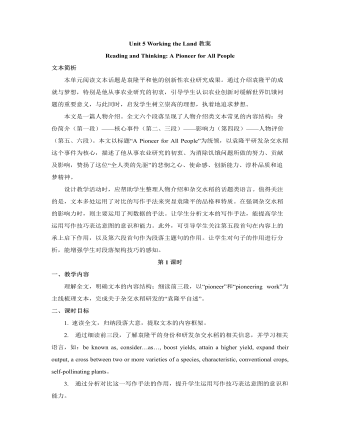
新人教版高中英语选修1Unit 5 Working the Land教案
1. 完成文本主要信息填空(斜体字部分设空):As a witness to farmers’ poor harvests and even a severe shortage of food, Yuan Longping was determined to devote his life to tackling this crisis. After graduation, he realized that what farmers needed most was to boost yields in the fields. Yuan was convinced that the answer lay in the creation of hybrid rice, one characteristic of which is that it usually achieve higher output than conventional crops. However, it was no easy job. The first difficulty he needed to overcome was scientists’ general assumption that this could not be done. Through trial and error, Yuan managed to generate this incredible crop. It is estimated that about 60 percent of domestic rice consumption in China was comprised of crops generated from Yuan’s hybrid strains. His innovation has enabled Chinese farmers to considerably expand their output and helped feed the world. Unwilling to retire early to a life of leisure and unconcerned about celebrity or fortune, Yuan continues to turn one vision after another into realities.2. 模仿写作:Do some research via the Internet and introduce another agricultural scientist, Chen Risheng(陈日胜), using the structure, expressions and writing techniques you have learnt from the text “A Pioneer for All People”.【设计意图】任务1是对文本内容和词汇学习成效的检测。任务2借助文本中学到的词汇和写作手法仿写另一位科学家,提升学生迁移运用词汇、文体结构和写作方法的能力。
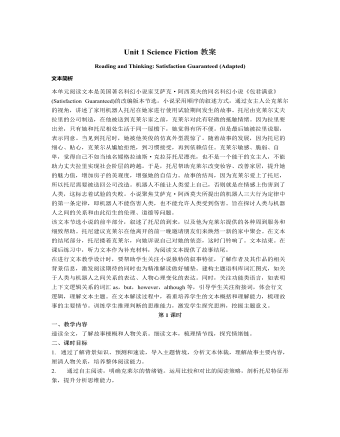
新人教版高中英语选修4Unit 1 Science Fiction教案
本活动旨在落实课时教学目标2。 1.Think, discuss and share. Students form groups of 4, discuss about the given ending make comments. Q1: Do you like the ending? Q2: Was it a logical ending? Why so or why not? [设计意图]通过引导学生思考、讨论、评价,比较个人、同伴所预测的结局和听力文本所给定的结局的异同点,深化对文本的认知,发展学生的评判性思维能力。 Activity 4: Exploring Asimov’s three laws of robotics and the purpose of the writing 本活动旨在落实课时教学目标3。 1. Get to know Isaac Asimov’s three laws of robotics. The teacher shares Isaac Asimov’s three laws of robotics. The three laws state that: ①A robot may not injure a human being or, through inaction, allow a human being to come to harm. ②A robot must obey any orders given to it by human beings, except where such orders would conflict with the First Law. ③A robot must protect its own existence as long as such protection does not conflict with the First or Second Law. Q: How does Tony’s story relate to the laws? 2. Figure out Isaac Asimov’s purpose of writing Satisfaction Guaranteed. The students express their opinions about the author’s writing purpose. Q: Why did Isaac Asimov write such a story? S: To explore the relationship between robots and humans. [设计意图]通过了解艾萨克·阿西莫夫所制定的机器人三大定律,加深学生对文本的理解,深入探究文本的主题意义。推理作者的写作目的,联系生活实际,思考人类与机器人的关系。
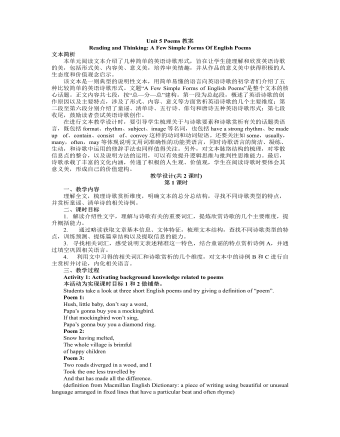
新人教版高中英语选修3Unit 5 Poems教案
本单元阅读文本介绍了几种简单的英语诗歌形式,旨在让学生能理解和欣赏英语诗歌的美,包括形式美、内容美、意义美,培养审美情趣,并从作品的意义美中获得积极的人生态度和价值观念启示。 该文本是一则典型的说明性文本,用简单易懂的语言向英语诗歌的初学者们介绍了五种比较简单的英语诗歌形式。文题“A Few Simple Forms of English Poems”是整个文本的核心话题。正文内容共七段,按“总—分—总”建构。第一段为总起段,概述了英语诗歌的创作原因以及主要特点,涉及了形式、内容、意义等方面赏析英语诗歌的几个主要维度;第二段至第六段分别介绍了童谣、清单诗、五行诗、俳句和唐诗五种英语诗歌形式;第七段收尾,鼓励读者尝试英语诗歌创作。 在进行文本教学设计时,要引导学生梳理关于与诗歌要素和诗歌赏析有关的话题类语言,既包括format、rhythm、subject、image等名词,也包括have a strong rhythm、be made up of、contain、consist of、convey这样的动词和动词短语。
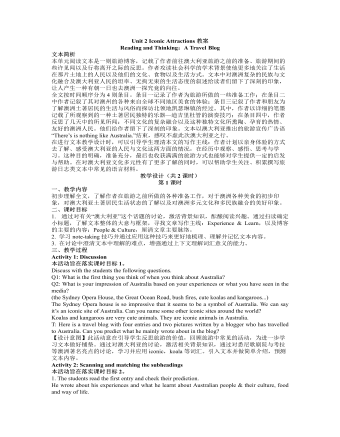
新人教版高中英语选修4Unit 2 Iconic Attractions教案
帮助学生通过讨论与对主题的提升,反思自己的旅游方式,以便做出更优化的安排,在今后的旅程中有更多的收益。 Activity 2: Further discussion of the 6 elements above and supplement of more background knowledge 本活动为实现课时教学目标2。 1.Target Q: The writer’s clear target of traveling, meeting the people and experiencing the culture, is closely related to his major in social studies. Then what is social studies? Social studies is a part of a school or college curriculum concerned with the study of social relationships and the functioning of society and usually made up of courses in history, government, economics, civics, sociology, geography, and anthropology. (Dictionary by Merriam-Webster) Reflection: When you go out to travel, what targets do you usually have in mind? 2.Research Q: Suppose you are traveling to Hangzhou during the school holidays, how will you do research on the city? (surf the internet, read books or travel brochures, consult friends, ...) What information will you be interested to know? (location, iconic sites, local cuisines, interesting customs, shopping malls ...) 3.Abandonment To make the most of time, we have to learn to abandon so that we can accomplish our plan. What will you be interested in doing if you go to Hangzhou if you have a week’s time? What if you only have 2 days? 4~5. Venturing & Experiencing Q: What did he venture to do during the trip? What new experiences did he have? In Sydney: attend his first open-air barbecue, enjoy many different but yummy meals In Catherine: observe the life and customs of the aborigines appreciate their music & try the musical instruments: the didgeridoo
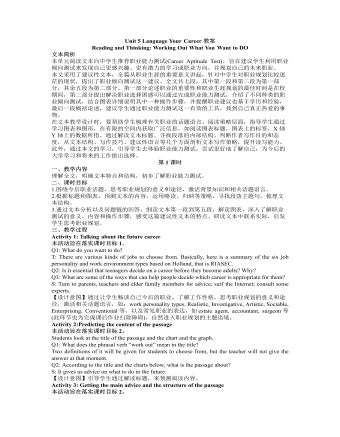
新人教版高中英语选修4Unit 5 Language Your Career教案
本单元阅读文本向中学生推荐职业能力测试(Career Aptitude Test),旨在建议学生利用职业倾向测试来发现自己更感兴趣、更有潜力的学习或职业方向,并规划自己的未来职业。 本文采用了建议性文本,全篇从职业生涯的重要意义讲起,针对中学生对职业规划比较迷茫的现状,提出了职业倾向测试这一建议。全文共七段,其中第一段和第二段为第一部分,其余五段为第二部分。第一部分论述职业的重要性和职业生涯规划的最佳时间是在校期间,第二部分提出解决职业选择困惑可以通过完成职业能力测试,介绍了不同种类的职业倾向测试,结合图表详细说明其中一种操作步骤,并提醒职业建议也基于学历和经验,最后一段概括论述,建议学生通过职业能力测试这一有效的工具,找到自己真正热爱的事物。 在文本教学设计时,要帮助学生梳理有关职业的话题语言。阅读策略层面,指导学生通过学习图表和图形,在有限的空间内获取广泛信息,如阅读图表标题,图表上的标签,X轴Y轴上的数据所指。

《念奴娇 赤壁怀古》说课稿(一) 统编版高中语文必修上册
一、说教材:(一)教材的地位和作用《念奴娇﹒赤壁怀古》是部编版高中语文教材必修上册第9课的课文。它与辛弃疾的《永遇乐﹒京口北固亭怀古》,李清照的《声声慢》共同入选该册教材第三单元阅读古诗词,感悟人生这一学习专题。本词是苏轼的代表作,也是豪放词的名篇,在古诗词教学中占有重要的地位。优美的诗词是中华传统文化的瑰宝,学习这些诗词的目的在于培养学生鉴赏古代诗词作品的能力,在分析、鉴赏中感悟前人丰饶的情思,博大的智慧,从而提高学生的人文素养,提高文化品味。这首词写于元丰五年,是苏轼被贬黄州游赤鼻矶所作。本词感情激荡,意境雄浑壮阔。全词融写景、咏史、抒情为一体。通过学习,学生可以获得一些鉴赏诗词的基本要领,领略壮阔意境,感受豪放词风;同时学习苏轼在逆境中依然乐观旷达的人生观。
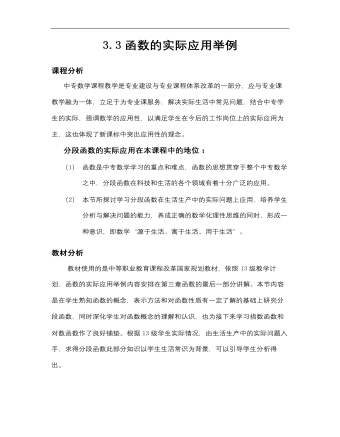
【高教版】中职数学基础模块上册:3.3《函数的实际应用举例》教学设计
课程分析中专数学课程教学是专业建设与专业课程体系改革的一部分,应与专业课教学融为一体,立足于为专业课服务,解决实际生活中常见问题,结合中专学生的实际,强调数学的应用性,以满足学生在今后的工作岗位上的实际应用为主,这也体现了新课标中突出应用性的理念。分段函数的实际应用在本课程中的地位:(1) 函数是中专数学学习的重点和难点,函数的思想贯穿于整个中专数学之中,分段函数在科技和生活的各个领域有着十分广泛的应用。(2) 本节所探讨学习分段函数在生活生产中的实际问题上应用,培养学生分析与解决问题的能力,养成正确的数学化理性思维的同时,形成一种意识,即数学“源于生活、寓于生活、用于生活”。教材分析 教材使用的是中等职业教育课程改革国家规划教材,依照13级教学计划,函数的实际应用举例内容安排在第三章函数的最后一部分讲解。本节内容是在学生熟知函数的概念,表示方法和对函数性质有一定了解的基础上研究分段函数,同时深化学生对函数概念的理解和认识,也为接下来学习指数函数和对数函数作了良好铺垫。根据13级学生实际情况,由生活生产中的实际问题入手,求得分段函数此部分知识以学生生活常识为背景,可以引导学生分析得出。
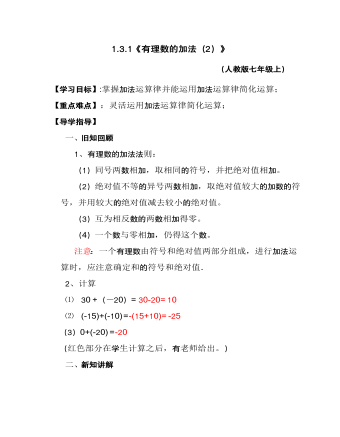
初中数学七年级上册第一章有理数加法第二课时
一、旧知回顾1、有理数的加法法则:(1)同号两数相加,取相同的符号,并把绝对值相加。(2)绝对值不等的异号两数相加,取绝对值较大的加数的符号,并用较大的绝对值减去较小的绝对值。(3)互为相反数的两数相加得零。(4)一个数与零相加,仍得这个数。注意:一个有理数由符号和绝对值两部分组成,进行加法运算时,应注意确定和的符号和绝对值.
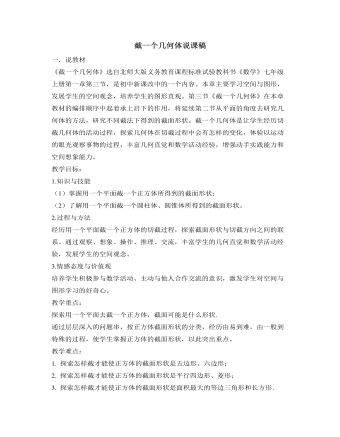
北师大初中数学七年级上册截一个几何体说课稿
接着引导学生进一步思考截面可不可以是特殊的三角形:等腰三角形和等边三角形。教师用课件演示切截过程,展示切截位置的变化引起截面形状的变化,图形特殊化。使学生的思考经历由一般到特殊的过程。2.截面是其他形状学生先猜想正方体的截面还有可能是什么形状,再利用实验操作型课件对正方体进行无限次的切截,让学生在无限次切截的过程中体会截面产生和变化的整个过程,发现截面产生和变化的规律。学生从切截活动中发现猜想时没有想到的截面图形,体会到探索的乐趣。教师再引导学生归纳正方体截面边数的规律。学生的认知得到升华。接着引导学生归纳截面形状中的特殊四边形。二.圆柱体和圆锥体的截面学生先猜想圆柱体的截面可能是什么形状,教师利用实验操作型课件对圆柱体进行无限次的切截,学生观察截面形状。
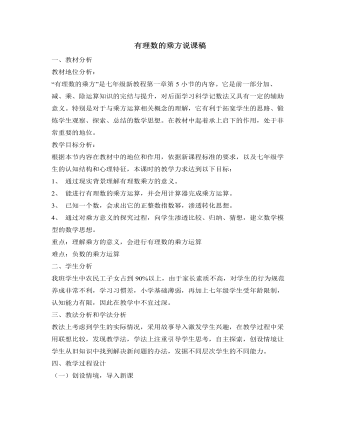
北师大初中数学七年级上册有理数的乘方说课稿
说明:此处进行的是一次尝试应用乘方运算来解决开头的问题,互相呼应,以体现整节课的完整性,把学生开始的兴趣再次引向高潮。趣味探索:一张薄薄的纸对折56次后有多厚?试验一下你能折这么厚吗?说明:这个探索实际上仍是对学生应用能力的一个检查,纸对折56次,用什么运算来计算比较方便,另外计算过程中可使用计算器,进一步加深对乘方意义的理解(五)作业P56页1、2说明:这两个习题是对课本上例题的简单重复和模仿,通过本节课的学习,多数学生应该可以较轻松地完成。总之,在整个教学设计中,我始终以学生为课堂主体,让他们积极参与到教学中来,不断从旧知识中获得新的认识,通过不断进行联系比较,让学生主动自觉地去思考、探索、总结直至发现结果、发现"方法",进而优化了整个教学。
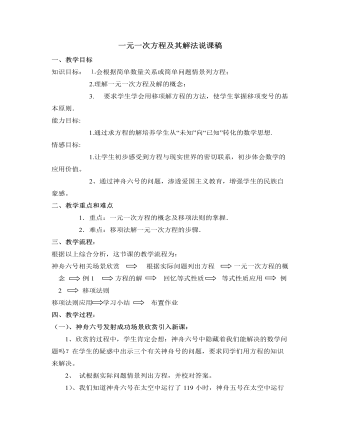
北师大初中数学七年级上册一元一次方程及其解法说课稿
还有其他解法吗?从中让学生体会解一元一次方程就是根据是等式的性质把方程变形成“x=a(a为已知数)”的形式(将未知数的系数化为1),这也是解方程的基本思路。并引导学生回顾检验的方法,鼓励他们养成检验的习惯)5、提出问题:我们观察上面方程的变形过程,从中观察变化的项的规律是什么?多媒体展示上面变形的过程,让学生观察在变形过程中,变化的项的变化规律,引出新知识.师提出问题:1.上述演示中,题目中的哪些项改变了在原方程中的位置?怎样变的?2.改变的项有什么变化?学生活动:分学习小组讨论,各组把讨论的结果上报教师,最好分四组,这样节省时间.师总结学生活动的结果:-2x改变符号后从等号的一边移到另一边。师归纳:像上面那样,把方程中的某项改变符号后,从方程的一边移到另一边的变形叫做移项.这里应注意移项要改变符号.
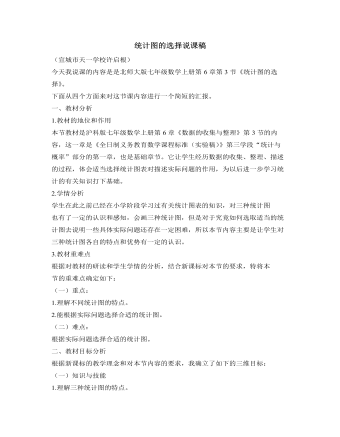
北师大初中数学七年级上册统计图的选择说课稿
四、教学过程分析为有序、有效地进行教学,本节课我主要安排了以下教学环节:(一)复习导入主要复习一下三种统计图,为接下来介绍三种统计图的特点及根据实际问题选取适当的统计图做好知识准备。(二)问题探究选取课本上“小华对1992~2002年同学家中有无电视机及近一年来同学在家看电视的情况”的3个调查项目,进而设计3个探究问题从而加深学生对每一种统计图的进一步认识,至此用自己的语言总结出每一种统计图的特点。(三)实践练兵这一环节通过2个实际问题的设计,通过学生对问题的分析、讨论,使学生认识到适当选取统计图有助于帮助人们去更快速、更准确地获取信息。(四)课堂小结总结这一节课所学的重点知识,这部分主要是让学生自己去总结,看看这节课自己有哪些收获。(五)作业布置进一步巩固本节课所学的知识,达到教学效果。以上就是我对这节课的见解,不足之处还望批评和指正。
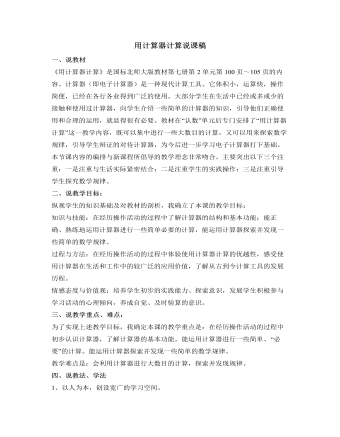
北师大初中数学七年级上册用计算器计算说课稿
一是先用计算器算出下面各题的积,再找一找有什么规律。目的是活跃气氛,激发学生探索数学规律的兴趣,为下面的数学探险作铺垫。二是数学探险。在这个步骤中,我先出示8个1乘8个1,学生用计算器计算的答案肯定不一样,因为学生带来的计算器所能显示的数位不一样,而且这些计算器所能显示的数位都不够用,也就是这道题目计算器不能解决。这时我提问:“你觉得问题出在哪儿?是我们错了,还是计算器错了?你能想办法解决吗?请四人小组讨论一下解决方案。”这样安排的目的是引发矛盾冲突,激发他们解决问题的需要和欲望。在学生找不到更好的解决方法时,引导学生向书本请教,完成课本第101页想想做做的第四题。让学生利用计算器算出前5题的得数,引导学生通过观察、比较、归纳、类比发现这些算式的规律,填写第6个算式,发展学生的合情推理能力,同时也让学生领略了数学的神奇。
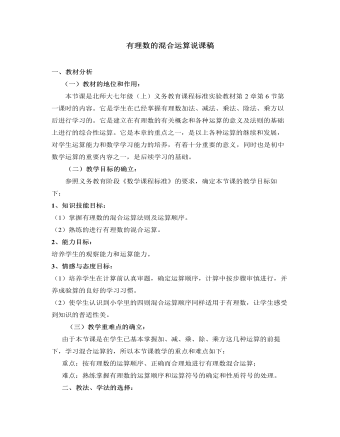
北师大初中数学七年级上册有理数的混合运算说课稿
一、教材分析(一)教材的地位和作用:本节课是北师大七年级(上)义务教育课程标准实验教材第2章第6节第一课时的内容。它是学生在已经掌握有理数加法、减法、乘法、除法、乘方以后进行学习的。它是建立在有理数的有关概念和各种运算的意义及法则的基础上进行的综合性运算。它是本章的重点之一,是以上各种运算的继续和发展,对学生运算能力和数学学习能力的培养,有着十分重要的意义,同时也是初中数学运算的重要内容之一,是后续学习的基础。(二)教学目标的确立:参照义务教育阶段《数学课程标准》的要求,确定本节课的教学目标如下:1、知识技能目标:(1)掌握有理数的混合运算法则及运算顺序。(2)熟练的进行有理数的混合运算。2、能力目标:培养学生的观察能力和运算能力。3、情感与态度目标:(1)培养学生在计算前认真审题,确定运算顺序,计算中按步骤审慎进行,并养成验算的良好的学习习惯。

北师大初中数学七年级上册有理数的乘法(1)说课稿
5. 作业: 作业我同样选取不同题型的五个计算题,目的是想查看学生学的效果如何,是否对哪类题型还留有疑问。 6. 自我评价: 这堂课我觉得满意的,是能够利用短暂的45分钟把要学的知识穿插在学与练当中,充分地利用了课堂有限的时间,并且能让学生边学边练,及时巩固。 当然这堂课也有很多不足之处,我觉得自己对于课堂上学生做练习时出现的一些小问题处理还没有能够处理得很好,我应该吸取经验教训,再以后的教学中加以改进。 另外对于多个有理数相乘时的符号问题,我觉得自己归纳得还不是很到位,我想解决的办法是在以后的练习中再做些补充,让学生加深理解。从中我也得到一个教训,再以后的教学工作中,我还应该多学习教学方法,多思考如何归纳知识点,才能更好地帮学生形成一个系统的知识系统!
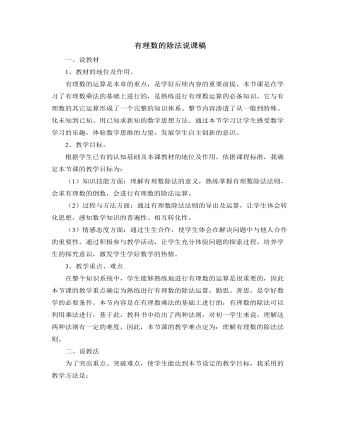
北师大初中数学七年级上册有理数的除法说课稿
五、两点说明。(一)、板书设计这节课的板书我是这样设计的,在黑板的正上方中间处写明课题,然后把板书分为左右两部分,左边是有理数除法的法则,为了培养学生把文字语言转化成符号语言的能力,板书中只出现两种法则的符号表示,从而加深他们对法则的理解,板书右边是学生的板演,以便于比较他们做题中出现的问题。板书下方是课堂小结,重点写出:有理数的除法可以转化成有理数的乘法,以体现本节课中的重要的数学思想方法。有理数的除法板演练习:有理数除法的法则:a÷b=a×1/b(b≠0) 1a>0,b>0,a/b>0;a0; 2a>0,b0,a/b<0. 3课堂小结:有理数的除法 有理数的乘法转化(二)、时间分配:教学过程中的八个环节所需的时间分别为:1分钟、2分钟、5分钟、8分钟、8分钟、16分钟、2分钟、1分钟。
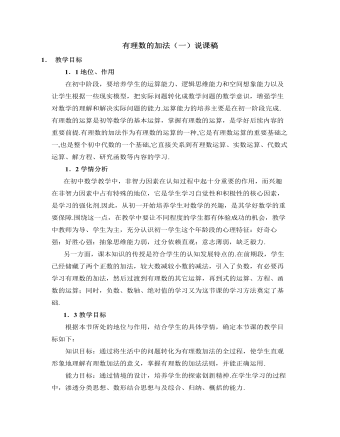
北师大初中数学七年级上册有理数的加法(一)说课稿
在答案的汇总过程中,要肯定学生的探索,爱护学生的学习兴趣和探索欲.让学生作课堂的主人,陈述自己的结果.对学生的不完整或不准确回答,教师适当延迟评价;要鼓励学生创造性思维,教师要及时抓住学生智慧的火花的闪现,这一瞬间的心理激励,是培养学生创造力、充分挖掘潜能的有效途径.预先设想学生思路,可能从以下方面分类归纳,探索规律:① 从加数的不同符号情况(可遇见情况:正数+正数;负数+负数;正数+负数;数+0)② 从加数的不同数值情况(加数为整数;加数为小数)③ 从有理数加法法则的分类(同号两数相加;异号两数相加;同0相加)④ 从向量的迭加性方面(加数的绝对值相加;加数的绝对值相减)⑤ 从和的符号确定方面(同号两数相加符号的确定;异号两数相加符号的确定)教学中要避免课堂热热闹闹,却陷入数学教学的浅薄与贫乏.

